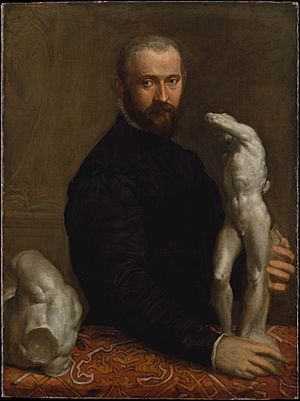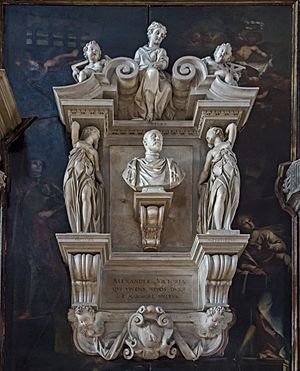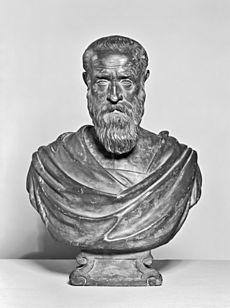Alessandro Vittoria facts for kids

Alessandro Vittoria (born 1525, died 1608) was a famous Italian sculptor. He was part of the Venetian school of art. People saw him as one of the most important sculptors of the late 1500s in Italy. He was even considered a rival to another great sculptor, Giambologna. Vittoria created many beautiful works, like his Annunciation sculpture.
About Alessandro Vittoria
Alessandro Vittoria was born in Trento, which is now in northern Italy. His father was a tailor. Vittoria learned his skills from a well-known architect and sculptor named Jacopo Sansovino. He lived at the same time as the famous painter Titian. Titian's style even influenced some of Vittoria's art.
Vittoria was very skilled at working with different materials. He often used terracotta, which is a type of clay, and sometimes covered it with gold. He also worked with marble and bronze. Like other Italian sculptors of his time, Vittoria was inspired by Michelangelo and another artist called Bartolomeo Ammanati.
Vittoria worked closely with important architects like Sansovino, Sanmicheli, and Palladio. He also collaborated with painters such as Titian, Tintoretto, and Veronese. This placed him right at the center of the art world in Venice during the late 1500s.
Vittoria's Artistic Journey
Vittoria first learned art in his hometown of Trento. Then, on July 25, 1543, he moved to Venice. There, he trained and worked with Jacopo Sansovino. Their artistic partnership lasted a long time, but it was sometimes difficult.
After one disagreement with Sansovino, Vittoria left Venice for a while. He went to Vicenza and worked there. He even teamed up with the painter Veronese on the decorations for the Villa Barbaro at Maser between 1560 and 1562. Later, he returned to Venice.
Vittoria and Sansovino worked together on many large sculpture projects until Sansovino passed away. After Sansovino's death, Vittoria took over his studio. He also finished any art projects Sansovino had started. Some of Vittoria's own students included Camillo Mariani and Andrea di Alessandro.
Vittoria became a member of the Scuola Grande di San Marco on January 24, 1563. He also joined the Accademia del Disegno in Florence around 1567.
Alessandro Vittoria died in Venice on May 27, 1608. His tomb, which includes a sculpture of his own face, is in the church of San Zaccaria.
Vittoria is well-known for his realistic portrait busts. These are sculptures of people's heads and shoulders. This type of art was not very common in Venice before him. He also made medals and full-body sculptures. Some of his full-body figures are placed on top of Sansovino's famous building, the Biblioteca Marciana.
Gallery
-
Anthony the Great San Francesco della Vigna
-
Saint Roch San Francesco della Vigna
-
Saint Roch San Salvador Venice
-
Saint Sebastian San Francesco della Vigna
-
Saint Sebastian San Salvador Venice
-
John the Evangelist San Zanipolo Venice
See also
 In Spanish: Alessandro Vittoria para niños
In Spanish: Alessandro Vittoria para niños












